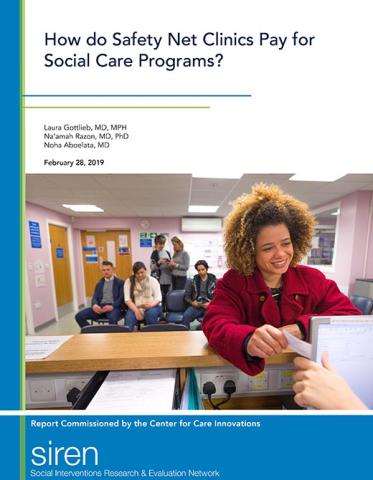How do safety net clinics pay for social care programs?
Social Interventions Research & Evaluation Network
As the evidence mounts demonstrating that social and economic circumstances shape health outcomes and costs, the health care sector is increasingly investing in activities to mitigate patients’ adverse social risks as a routine part of health care delivery. Hardly a day goes by without a new health care report or conference announcement that highlights the importance of addressing social context as a strategy for improving health and well-being. Many health care stakeholders—including providers, clinics, hospitals, health systems, and health plans—are now innovating at this intersection.
Though social determinants of health (SDH) are now in vogue in new places within the US health care delivery sector, they have always been part of the mortar of the community health center movement. Community health centers were established in the 1960s as one of the War on Poverty programs. They now comprise a core part of the safety-net for low-income Medicaid and uninsured populations. Earlier work has emphasized the importance and extent of social care activities in the community health center context. To date, relatively little work has explored how health centers and other safety net clinics financially support these activities.
With support from the Center for Care Innovations, we undertook this project to better understand the innovative ways in which health centers and other safety net clincs braid different funding streams to implement and sustain SDH-related programs. To do that, we interviewed over 30 experts from federal, state, and local levels, including from government, hospital and health care systems, non-medical community-based organizations, and health center leaders; interviewed leaders from four safety net clinics in diverse areas of the U.S. that are actively engaged in different kinds of social care programs; and reviewed the existing literature on health center financing.
We learned about the great variety of ways in which safety net clinic innovators initiate and sustain social care programs, as well as the many barriers they face in that work. They leverage funding in patient revenue streams, apply for a surprising number of time-limited grants, and are constantly on the lookout for non-traditional revenue-generating opportunities, like social enterprises. In this brief, we describe approaches that relate to Medicaid coverage and reimbursement and highlight the impressive range of grant proposals written and awarded.
In each report section, we also describe challenges of each financing strategy. The consequence of those challenges is that social care programs in health centers and other safety net clinics are regularly threatened with funding gaps and shortages. Funding received from patient revenue or grant sources is typically less than the degree of patient need. Often funds are restricted to special complex care populations or target age groups. Even when there is more flexibility, other obstacles arise related to grant cycles, grant duration, and funder preferences. The human and financial capital spent on identifying funding sources, writing grant proposals, and reporting activities to different funders strongly limit both initial program investments and program sustainability.
We hope that this report serves two purposes. First, for safety net clinic leaders, it may spark ideas about strategies to support existing or new programs. For policy-makers and advocates, it ideally also will shed light on ways to change the existing system so that safety net clinics can continue to provide the services that the evidence increasingly suggests are necessary to meet the needs of patients facing socioeconomic barriers to health. Ultimately, to improve the capacity of safety net providers to coordinate and deliver social care will require not only more funding but more funding stability. The most promising future sources of revenue lie in Medicaid-related programs—and new opportunities around value-based and risk-adjusted payments are likely to grow as CMS’ work develops in this area. In the meantime, safety net leaders hoping to expand social care services will need to continue leveraging the wide range of state innovations, existing value-based care opportunities, federal, state, and local government or private grants that have enabled them to initiate and sustain their social care programs to date.
Gottlieb L, Razon N, & Aboelata N. How do Community Health Centers Pay for Social Care Programs? San Francisco, CA: SIREN; 2019: Available at: https://sirenetwork.ucsf.edu/tools-resources/resources/how-do-safety-net....
